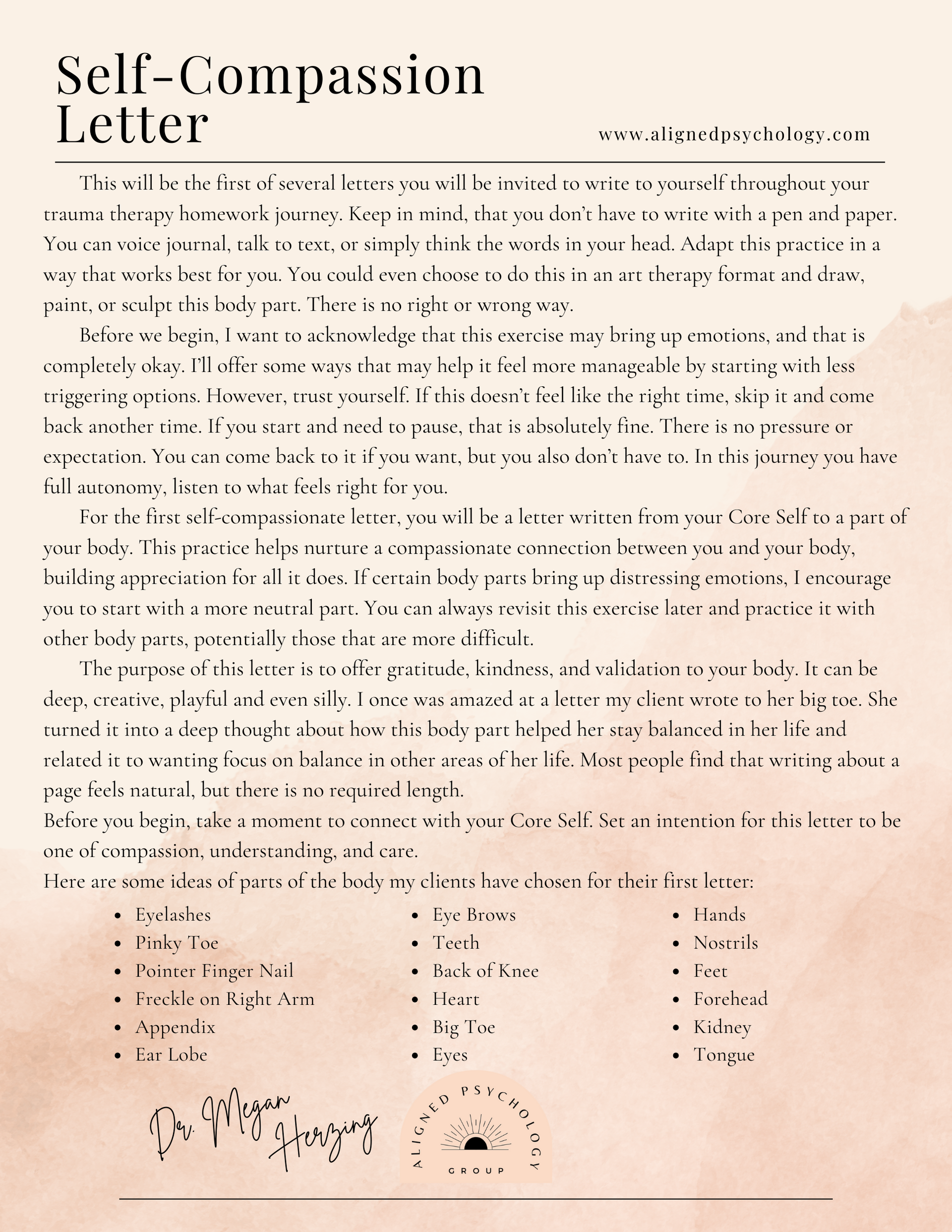Trauma Therapy Homework - Week 19
Week 20: (The Basics)
Self-Compassion Letter
Welcome to Week 20 of your trauma therapy homework! You’ve come such a long way on this journey. Whether you’ve done every single assignment or you’re popping in and out as you need—your commitment to showing up for yourself is deeply valid and worth honoring. This week, we’re diving into a practice that might feel new or tender (or even a little strange at first): writing a self-compassion letter to a part of your body. Before we jump into the how, let’s talk a little about the why.
Our bodies are often the carriers of our trauma. They hold the memories, the tension, the protection, and the pain. Sometimes, we disconnect from our bodies because it feels safer that way. Other times, we judge them harshly, blame them, or ignore them altogether. But our bodies have been with us through it all. And more importantly, our bodies are not the enemy—they’re trying to help us survive. This letter-writing exercise is a way to work on mending and deepening the relationship you have with your body. It’s a chance to speak directly from your Core Self—the calm, compassionate, wise part of you—to a part of your body that maybe doesn’t get enough appreciation. Or maybe gets too much criticism. Or maybe you’ve never even thought about that body part at all. By practicing gratitude, kindness, and even playfulness, this exercise gently teaches your nervous system that you can connect to your body. That compassion is possible. That your body has good intentions for you and is doing its best. And that your body, in all its complexity, deserves your presence and care.

Important Reminders Before You Begin
Let’s pause for a moment before diving in. This practice might bring up some feelings—sadness, frustration, grief, love, even awkwardness. That’s okay. That’s all allowed.
Here are a few gentle reminders to help support you:
- You don’t have to write in the traditional way. You can voice journal, use talk-to-text, type on your phone or laptop, or even just think the words in your head.
- You can turn this into art therapy—draw, sculpt, paint, or collage your response.
- You are encouraged to start with a neutral body part—one that doesn’t carry strong emotional weight. You’re always welcome to revisit more challenging areas later.
- If at any point it feels overwhelming, you can pause or stop. There’s no pressure. There’s no “should.”
- This is your practice. You have full autonomy here. Listen to your needs.
What Is a Self-Compassionate Letter?
A self-compassionate letter is written from the voice of your Core Self (your internal observer). This part of you is not critical or harsh. It doesn’t rush or judge. It’s calm, caring, curious, and connected. You might imagine it as the version of you who shows up when you’re supporting a friend. It listens deeply. It offers compassion. You’ll be writing from Core Self to a body part of your choosing. The letter is a way of saying: I see you. I appreciate you. I’m sorry if I’ve ignored or judged you. I’m here now. It doesn’t have to be long or poetic. It doesn’t have to follow any structure. It can be silly, serious, symbolic, spiritual, or simple. There is no wrong way to do this.
What to Include in Your Letter
Here are a few gentle prompts to help guide your writing:
- Start by acknowledging the body part: “Dear hands,” or “Hi, eyelashes.”
- Offer gratitude: What does this body part do for you? What has it helped you survive or experience?
- Validate its role: Has it protected you? Worked hard for you? Adapted to what you’ve needed?
- Offer kindness: Let it know you see it. That you’re learning to care for it. That you’re sorry if you’ve ignored or criticized it.
You can make it playful, too. One client wrote to her big toe and joked about how it was always bumping into furniture but kept her grounded, centered, and balanced. These small moments of humor are also healing.
Choosing a Body Part to Write To
You might already have a body part in mind—or you might feel unsure. That’s okay. Here are some ideas my clients have chosen for their first letter, often starting with more neutral or less emotionally charged parts:
- Eyelashes
- Pinky toe
- Pointer finger nail
- Freckle on your arm
- Appendix
- Ear lobe
- Eyebrows
- Teeth
- Back of your knee
- Heart
- Big toe
- Eyes
- Hands
- Nostrils
- Feet
- Forehead
- Kidney
- Tongue
Pick something that feels doable. Something that doesn’t immediately bring up intense shame or distress (unless you feel grounded and supported in working with that part).

What If This Feels Weird or Hard?
Totally normal. This practice isn’t something most of us are taught. We’re often taught to disconnect from our bodies—especially in trauma, especially in systems that prioritize productivity over presence. So, if it feels weird, forced, or emotional, take a breath. You’re not doing it wrong. You’re just stretching a new muscle. Compassion, like anything, gets stronger with practice. You don’t need to write the “right” thing. Just show up. Be real. Be kind.
Once you’ve written your letter, take a moment to sit with it. Read it aloud if that feels okay. Place your hands on the body part if it feels safe. Breathe with it. Notice what comes up. You might feel tenderness. You might feel relief. You might feel nothing. You might feel activated. All of it is valid. If you feel comfortable, share your letter with someone you trust.

This Week’s Practice
Here’s your gentle invitation for the week:
- Choose a body part to write to—start with a neutral one if you can.
- Connect to your Core Self—breathe, ground, and center for a few minutes. Connect with your authentic, compassionate self.
- Write the letter in any format that works for you.
- Read it back, reflect, and notice what it feels like to receive your own compassion.
- Optional: Share it with someone or keep it in a sacred space.
You can repeat this practice anytime. You can write to different body parts each time. You can do it weekly or monthly. Many clients choose to work slowly and gently toward more difficult body parts, those that bring up hard emotions.
Final Thoughts
This practice is about presence. It’s about remembering that your body is not just a container for your trauma—it’s also a container for your resilience, your creativity, your joy, and your strength. Your Core Self has the capacity to meet every part of you with kindness including your body. This letter is just one step in that direction. You deserve to be met with compassion. Your body deserves to be appreciated. You deserve to speak gently to yourself. So this week, after your letter, notice what softens. You're doing beautifully. Until next time, be gentle with yourself. You’re not alone in this.
FREE Downloadable Handouts
Click this LINK for free access to downloadable PDFs from the Trauma Therapy Homework Series. You’ll be directed to my Google Drive folder, where you can explore all the handouts created so far. You can choose between a digital format for easy viewing on your device or a printable version if you prefer a hard copy.
Here is a preview of this week's handout! Click the link above to get your own free pdf copy.


ABOUT THE AUTHOR
Dr. Megan
Megan Herzing PsyD, Licensed Professional Clinical Counselor, specializes in trauma therapy and creating a safe, supportive space for healing. She integrates evidence-based modalities, including EMDR, Internal Family Systems (IFS), somatic therapy, and Emotionally Focused Therapy (EFT), to address the mind-body connection and empower clients on their journey to wellness. With extensive experience treating complex PTSD, anxiety, attachment injuries, and dissociation, she believes in the power of self-compassion and authentic connection to facilitate lasting change. Drawing from her own healing journey, she brings empathy and lived experience to her work, honoring each client’s unique path toward growth and resilience.
Thank you for being part of a community of humans that deeply cares about healing.
We are honored that you stopped by and hope our resources will continue to bring value to your life.
We are accepting new clients in California, and referrals are always appreciated.












